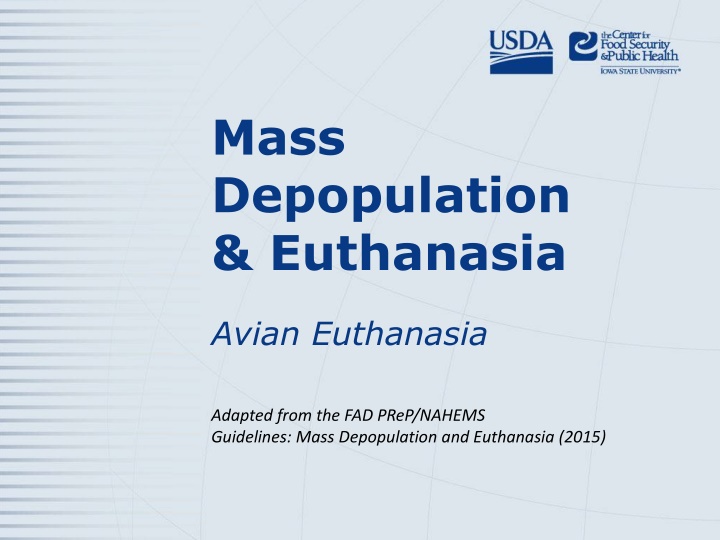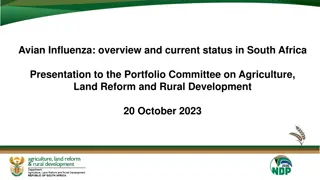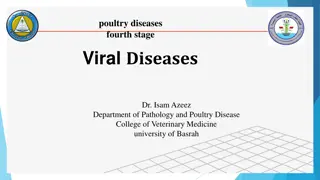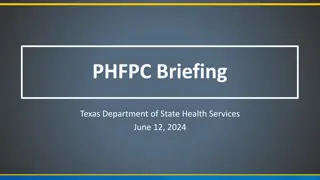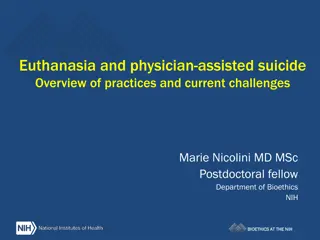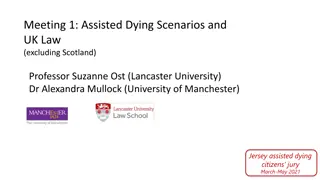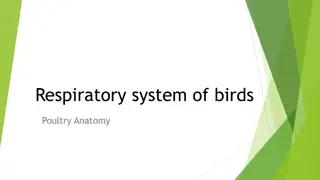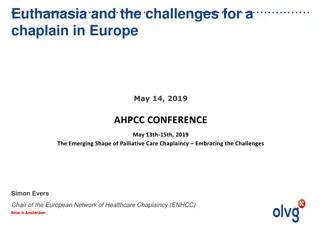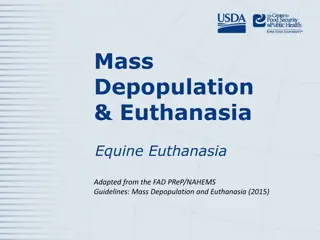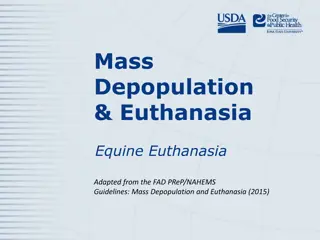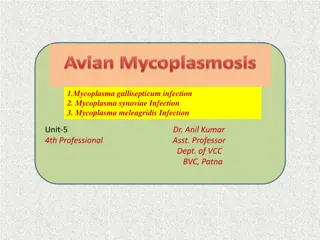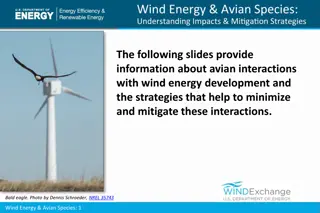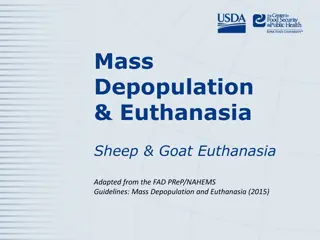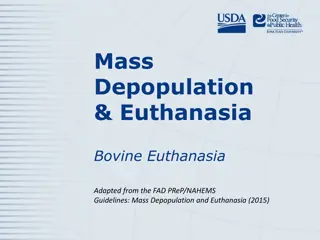Guidelines for Avian Euthanasia and Mass Depopulation
Avian euthanasia and mass depopulation are crucial processes in animal health emergencies. This involves transitioning animals painlessly, maintaining welfare, and preventing disease spread. Methods such as injectables, inhalants, and physical methods are utilized, all aiming to provide a humane and stress-free treatment while safeguarding the food chain.
Download Presentation

Please find below an Image/Link to download the presentation.
The content on the website is provided AS IS for your information and personal use only. It may not be sold, licensed, or shared on other websites without obtaining consent from the author.If you encounter any issues during the download, it is possible that the publisher has removed the file from their server.
You are allowed to download the files provided on this website for personal or commercial use, subject to the condition that they are used lawfully. All files are the property of their respective owners.
The content on the website is provided AS IS for your information and personal use only. It may not be sold, licensed, or shared on other websites without obtaining consent from the author.
E N D
Presentation Transcript
Mass Depopulation & Euthanasia Avian Euthanasia Adapted from the FAD PReP/NAHEMS Guidelines: Mass Depopulation and Euthanasia (2015)
Euthanasia and Depopulation Euthanasia Transitioning painlessly and stress-free as possible Mass Depopulation Large numbers, quickly and efficiently Consideration to welfare as practicable Terms used interchangeably here FAD PReP/NAHEMS Guidelines: MDE- Avian USDA APHIS and CFSPH
Euthanasia and Depopulation May be practiced during an animal health emergency Goals of Euthanasia Provide humane treatment Select acceptable method Minimize negative emotional impact Safeguard food chain Prevent or mitigate disease spread FAD PReP/NAHEMS Guidelines: MDE- Avian USDA APHIS and CFSPH
Handling Goal: Humane reatment Decrease animal stress, excitement Competent, trained and experienced personnel Restrain without undue injury or pain Handle animals quietly FAD PReP/NAHEMS Guidelines: MDE- Avian USDA APHIS and CFSPH
Euthanasia Methods Acceptable (noninhalant) Conditionally acceptable Adjunct Other Consider disease agent when choosing method Zoonotic potential FAD PReP/NAHEMS Guidelines: MDE- Avian USDA APHIS and CFSPH
Noninhalant Injectables Injectable barbituates Barbituate derivates FAD PReP/NAHEMS Guidelines: MDE- Avian USDA APHIS and CFSPH
Inhalant Conditionally acceptable Carbon dioxide Carbon monoxide Nitrogen Argon FAD PReP/NAHEMS Guidelines: MDE- Avian USDA APHIS and CFSPH
Physical Methods Conditionally acceptable Cervical dislocation Decapitation Electrocution Gunshot Percussive stunning/Captive bolt Manually applied blunt force trauma FAD PReP/NAHEMS Guidelines: MDE- Avian USDA APHIS and CFSPH
Additional Methods For mass/emergency depopulation Water-based foam for land-based poultry and waterfowl Ventilation shut down FAD PReP/NAHEMS Guidelines: MDE- Avian USDA APHIS and CFSPH
Adjunct Methods Potassium chloride or magnesium sulfate IV or Intracardiac Exsanguination (consider biosecurity) Bird MUST be unconscious FAD PReP/NAHEMS Guidelines: MDE- Avian USDA APHIS and CFSPH
Injectable Chemical Agents Small number of birds, companion birds Intraperitoneal injection Nonirritating euthanasia agent Restrain with Ketamine hydrochloride, if necessary Death is prolonged when compared to intravenous methods FAD PReP/NAHEMS Guidelines: MDE- Avian USDA APHIS and CFSPH
Types of Gaseous Agents CO2 used extensively Heavier than air, will remain near floor Nitrogen, argon Specific gravity similar to air Does not sink Must be used in a completely closed system FAD PReP/NAHEMS Guidelines: MDE- Avian USDA APHIS and CFSPH
Physical- Cervical Dislocation Should only be performed by well-trained individuals Only practical if: Small birds Small number to be euthanized Tissues collection When learning technique, sedate or anesthetize birds first FAD PReP/NAHEMS Guidelines: MDE- Avian USDA APHIS and CFSPH
Physical- Decapitation Not recommended in mass depopulation situations Risk of disease spread Offensive Stressful to birds and responders Inefficient Welfare concerns FAD PReP/NAHEMS Guidelines: MDE- Avian USDA APHIS and CFSPH
Physical- Percussive Stunning Cash Poultry Killer (CPK) Chickens, turkeys, ducks, geese Cartridge-powered New cartridge for each use May overheat with continuous use Air-powered Intended for production slaughter FAD PReP/NAHEMS Guidelines: MDE- Avian USDA APHIS and CFSPH
Physical- Electrocution Successfully used with poultry Mobile electrical water bath systems On-farm stunning, euthanasia Sufficient to kill without need for adjunct method Requires individual handling and leg- shackling necessary No existing electrocution mass depopulation systems in the U.S. FAD PReP/NAHEMS Guidelines: MDE- Avian USDA APHIS and CFSPH
Physical- Gunshot Acceptable for small number of feral/wild birds that cannot be moved, trapped Use appropriate shot size Acceptable for large birds or ratites FAD PReP/NAHEMS Guidelines: MDE- Avian USDA APHIS and CFSPH
Water-Based Foam Advantages: Decreased labor Little/no bird handling Decreases dust Disadvantages: Water supply Birds must be on floor FAD PReP/NAHEMS Guidelines: MDE- Avian USDA APHIS and CFSPH
Confirmation of Death Confirmation of death can be difficult Sustained lack of heartbeat and respiration Rigor mortis Evaluate by competent, experienced personnel FAD PReP/NAHEMS Guidelines: MDE- Avian USDA APHIS and CFSPH
For More Information FAD PReP/NAHEMS Guidelines: Mass Depopulation and Euthanasia (MDE) (2015) http://www.aphis.usda.gov/fadprep MDE web-based training module http://naherc.sws.iastate.edu/ FAD PReP/NAHEMS Guidelines: MDE- Avian USDA APHIS and CFSPH
Guidelines Content Authors (CFSPH): Rene Dewell DVM,MS Nichollette Rider, Veterinary Student Significant contributions to the content were provided by USDA APHIS VS: Lori P. Miller, PE Darrel K. Styles, DVM, PhD FAD PReP/NAHEMS Guidelines: MDE- Avian USDA APHIS and CFSPH
Acknowledgments Development of this presentation was by the Center for Food Security and Public Health at Iowa State University through funding from the USDA APHIS Veterinary Services PPT Authors: Dawn Bailey, BS; Kerry Leedom Larson, DVM, MPH, PhD, DACVPM Reviewers: Glenda Dvorak, DVM, MPH, DACVPM: Cheryl L. Eia, JD, DVM, MPH, Patricia Futoma, BS, Veterinary Student, Rene Dewell DVM,MS
